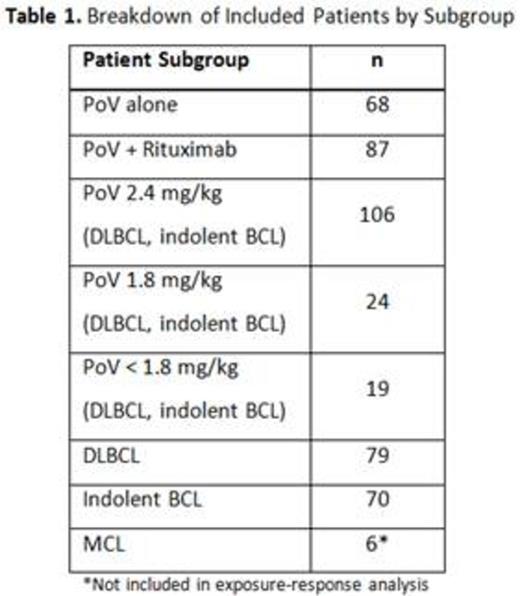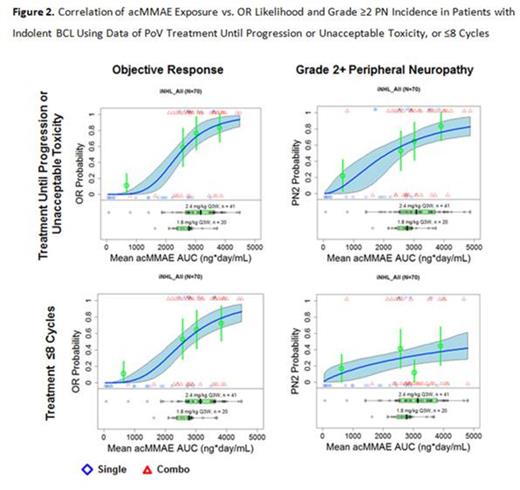Abstract
Introduction
Polatuzumab vedotin (PoV), an antibody-drug-conjugate containing the microtubule inhibitor monomethyl auristatin E (MMAE), is in development for the treatment of B-cell lymphoma (BCL). In phase 1 and 2 studies assessing PoV alone or in combination with rituximab (RTX), PoV treatment until disease progression was associated with high discontinuation rates due to peripheral neuropathy (PN) at the dose of 2.4 mg/kg. Therefore, dose and schedule optimization, including justification of body weight-based dosing, dose capping, and selection of dose level and treatment durations, were evaluated to maximize efficacy and reduce the rate of treatment-emergent PN.
Methods
Population pharmacokinetics (Pop-PK) for antibody-conjugated MMAE (acMMAE) and exposure-response (E-R) analyses were conducted. A Pop-PK model was developed including clinically relevant covariates recorded in phase 1 and 2 studies of PoV administered every 3 weeks (N=155; Table 1). A simulation was performed to compare acMMAE PK variability with body weight-based vs. fixed dosing. Exposure to acMMAE was also simulated in patients ≥101.9 kg (90th percentile of body weight) receiving a hypothetical capped PoV dose of 240 mg. E-R analyses were stratified by histology, with efficacy based on overall response (OR, complete or partial response per revised IWG criteria [Cheson et al. 2007]) and safety based on the incidence of grade ≥2 PN. Logistic regression and time-to-event analyses were conducted. E-R analyses were also performed to compare safety and efficacy through 8 cycles of treatment vs. treatment discontinuation for disease progression or unacceptable toxicity.
Results
Pop-PK analysis for acMMAE identified body weight as a significant covariate for both clearance (CLinf) and central volume of distribution (Vc). Simulation suggested that body weight-based dosing (2.4 mg/kg) would result in much lower PK variability than fixed dosing (185.5 mg), with a trend towards slightly higher exposure for patients ≥101.9 kg (Figure 1). This trend of higher exposure was not observed if the PoV dose was capped to 240 mg for these patients.
E-R analyses suggested that higher acMMAE exposure was associated with increased likelihood of OR for patients with indolent BCL (including follicular, marginal zone, and small lymphocytic lymphomas; Figure 2) or diffuse large BCL (DLBCL). When acMMAE exposure was translated to the PoV dose, the covariate-adjusted odds ratio (90% confidence interval [CI]) of OR for PoV 2.4 vs. 1.8 mg/kg was 1.73 (1.29-1.74) and 2.39 (1.43-6.13) for indolent BCL and DLBCL, respectively. The effect of adding RTX on PoV efficacy was not statistically significant. Grade ≥2 PN incidence increased with acMMAE exposure for both indolent BCL (Figure 2) and DLBCL. Furthermore, time-to-event analysis indicated that the rate of grade ≥2 PN increased with treatment duration.
Based on safety and efficacy through 8 cycles of treatment, the incidence of grade ≥2 PN was decreased, while the higher OR probability for 2.4 mg/kg dose was maintained in both indolent BCL (Figure 2) and DLBCL patients. The time-to-event analysis suggested that treatment with ≤8 cycles of PoV resulted in a model-predicted incidence (90% CI) of grade ≥2 PN events of 28.9% (21.3-34.7%) and 35.1% (26.2-41.7%) for 1.8 and 2.4 mg/kg, respectively.
Conclusions
Body weight-based dosing for all patients with capping the PoV dose at 240 mg for heavy patients (≥101.9 kg) provides lower PK variability for all patients than fixed dosing and may mitigate potential safety risks for heavy patients. When given alone or in combination with RTX, a PoV dose of 2.4 mg/kg is associated with a higher likelihood of achieving an OR compared with 1.8 mg/kg. Capping treatment to ≤8 cycles may mitigate treatment-emergent PN risk. Thus, selection of PoV dose and/or capping of treatment duration may offer an optimal benefit-risk profile. Current clinical studies are testing PoV 1.8 mg/kg limited to 6-8 cycles to further mitigate safety risk when given in combination with immunochemotherapy or novel small molecule pathway inhibitors. Future clinical testing at the 2.4 mg/kg dose level may also be warranted.
Lu:Genentech, Inc.: Employment, Equity Ownership. Off Label Use: Polatuzumab vedotin is an investigational agent and not approved in B-cell lymphoma. Jin:Genentech, Inc.: Employment. Gibiansky:Genentech, Inc.: Consultancy. Gillespie:Genentech, Inc.: Consultancy. Agarwal:Genentech, Inc.: Employment. Jones:Genentech, Inc.: Employment. Chu:Genentech, Inc.: Employment. Wenger:Genentech, Inc.: Employment. Hirata:Genentech, Inc.: Employment, Equity Ownership. Li:Genentech, Inc.: Employment. Girish:Genentech, Inc.: Employment.
Author notes
Asterisk with author names denotes non-ASH members.




This feature is available to Subscribers Only
Sign In or Create an Account Close Modal